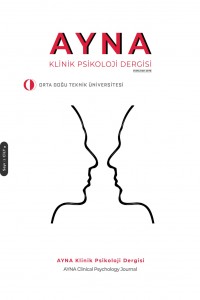Öz
Anahtar Kelimeler
Lacanian approach obsessional neurosis paternal function L schema phallus
Kaynakça
- Dor, J. (1998). Introduction to the Reading of Lacan: The Unconscious Structured Like a Language. New York: Other Press.
- Dor, J. (1999). The Clinical Lacan. New York: Other Press, LLC.
- Evans, D. (1996). An Introductory Dictionary of Lacanian Psychoanalysis. London: Routledge.
- Fink, B. (1995). The Lacanian Subject: Between Language and Jouissance. Princeton, New Jersey: Princeton University Press.
- Fink, B. (1997). A Clinical Introduction to Lacanian Psychoanalysis: Theory and Technique. Cambridge: Harvard University Press.
- Fink, B. (2004). Lacan to the Letter: Reading Ecrits Closely. Minneapolis, MN: University of Minnesota Press.
- Fink, B. (2014). Against Understanding, Cases and Commentary in a Lacanian Key, Volume 2. London and New York: Routledge.
- Freud, S. (2010). Notes upon a case of obsessional neurosis (I. Smith çev.). I. Smith (Ed.), Freud- Complete Works içinde (ss. 2125-2194). London, England: Hogarth Press. (1909)
- Freud, S. (2010). Negation (I. Smith çev.). I. Smith (Ed.), Freud-Complete Works içinde (ss. 4140-4143). London, England: Hogarth Press. (1925)
- Grigg, R. (2008). Lacan, Language, and Philosophy. Albany, New York: State University of New York Press.
- Lacan, J. (1956-1957). The seminar of Jacques Lacan, book IV: The object relations & Freudian structures. (C. Gallagher, çev.). Erişim adresi http://www.lacaninireland.com/web/translations/seminars/
- Lacan, J. (2001). Ecrits: A Selection (A. Sheridan, çev.). London and New York: Routledge Classics. (1966)
- Lacan, J. (2006). Ecrits: The First Complete Edition in English (B. Fink, çev.). New York: W. W. Norton & Company. (1966-1971)
- Lacan, J. (2014). Anxiety: The Seminar of Jacques Lacan: Book X (A. R. Price, çev.). Cambridge: Polity Press. (1962-1963)
- Lacan, J. (2017). Baba-nın-Adları (M. Erşen, çev.). İstanbul: MonoKL. (1953-1963)
- Leader, D. (2016). Delilik Nedir? (B. E. Aksoy, çev.). İstanbul: Encore Yayınları.
- Melman, C. (2003). On obsessional neurosis. Slavoj Zizek (Ed.), Jacques Lacan, Critical Evaluations in Cultural Theory, Volume I: Psychoanalytic Theory and Practice içinde (ss. 117-125). London and New York: Routledge.
- Miller, C. (1996). An introduction to seminars I and II: Lacan’s orientation prior to 1953 (III). R. Feldstein, B. Fink ve M. Jaanus (Edl.), Reading Seminars I and II: Lacan’s Return to Freud içinde (ss. 26-35). New York, NY: State University of New York Press.
- Soler, C. (1996). Hysteria and obsession. R. Feldstein, B. Fink ve M. Jaanus (Edl.), Reading Seminars I and II: Lacan’s Return to Freud i inde (ss. 248-282). New York, NY: State University of New York Press.
Öz
Anahtar Kelimeler
Lacanyen yaklaşım obsesyonel nevroz baba işlevi L şeması fallus
Kaynakça
- Dor, J. (1998). Introduction to the Reading of Lacan: The Unconscious Structured Like a Language. New York: Other Press.
- Dor, J. (1999). The Clinical Lacan. New York: Other Press, LLC.
- Evans, D. (1996). An Introductory Dictionary of Lacanian Psychoanalysis. London: Routledge.
- Fink, B. (1995). The Lacanian Subject: Between Language and Jouissance. Princeton, New Jersey: Princeton University Press.
- Fink, B. (1997). A Clinical Introduction to Lacanian Psychoanalysis: Theory and Technique. Cambridge: Harvard University Press.
- Fink, B. (2004). Lacan to the Letter: Reading Ecrits Closely. Minneapolis, MN: University of Minnesota Press.
- Fink, B. (2014). Against Understanding, Cases and Commentary in a Lacanian Key, Volume 2. London and New York: Routledge.
- Freud, S. (2010). Notes upon a case of obsessional neurosis (I. Smith çev.). I. Smith (Ed.), Freud- Complete Works içinde (ss. 2125-2194). London, England: Hogarth Press. (1909)
- Freud, S. (2010). Negation (I. Smith çev.). I. Smith (Ed.), Freud-Complete Works içinde (ss. 4140-4143). London, England: Hogarth Press. (1925)
- Grigg, R. (2008). Lacan, Language, and Philosophy. Albany, New York: State University of New York Press.
- Lacan, J. (1956-1957). The seminar of Jacques Lacan, book IV: The object relations & Freudian structures. (C. Gallagher, çev.). Erişim adresi http://www.lacaninireland.com/web/translations/seminars/
- Lacan, J. (2001). Ecrits: A Selection (A. Sheridan, çev.). London and New York: Routledge Classics. (1966)
- Lacan, J. (2006). Ecrits: The First Complete Edition in English (B. Fink, çev.). New York: W. W. Norton & Company. (1966-1971)
- Lacan, J. (2014). Anxiety: The Seminar of Jacques Lacan: Book X (A. R. Price, çev.). Cambridge: Polity Press. (1962-1963)
- Lacan, J. (2017). Baba-nın-Adları (M. Erşen, çev.). İstanbul: MonoKL. (1953-1963)
- Leader, D. (2016). Delilik Nedir? (B. E. Aksoy, çev.). İstanbul: Encore Yayınları.
- Melman, C. (2003). On obsessional neurosis. Slavoj Zizek (Ed.), Jacques Lacan, Critical Evaluations in Cultural Theory, Volume I: Psychoanalytic Theory and Practice içinde (ss. 117-125). London and New York: Routledge.
- Miller, C. (1996). An introduction to seminars I and II: Lacan’s orientation prior to 1953 (III). R. Feldstein, B. Fink ve M. Jaanus (Edl.), Reading Seminars I and II: Lacan’s Return to Freud içinde (ss. 26-35). New York, NY: State University of New York Press.
- Soler, C. (1996). Hysteria and obsession. R. Feldstein, B. Fink ve M. Jaanus (Edl.), Reading Seminars I and II: Lacan’s Return to Freud i inde (ss. 248-282). New York, NY: State University of New York Press.
Ayrıntılar
| Birincil Dil | Türkçe |
|---|---|
| Konular | Psikoloji |
| Bölüm | Kuramsal Derleme |
| Yazarlar | |
| Yayımlanma Tarihi | 28 Haziran 2021 |
| Gönderilme Tarihi | 24 Ekim 2020 |
| Kabul Tarihi | 23 Mart 2021 |
| Yayımlandığı Sayı | Yıl 2021 Cilt: 8 Sayı: 2 |
Cited By
Psikotik Yapı, Baba İşlevi ve Lacanyen Kavramsallaştırma
AYNA Klinik Psikoloji Dergisi
https://doi.org/10.31682/ayna.1282059

